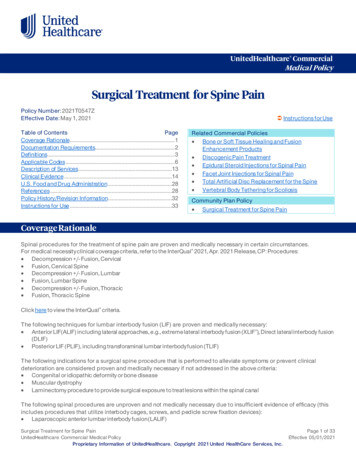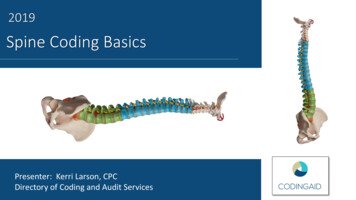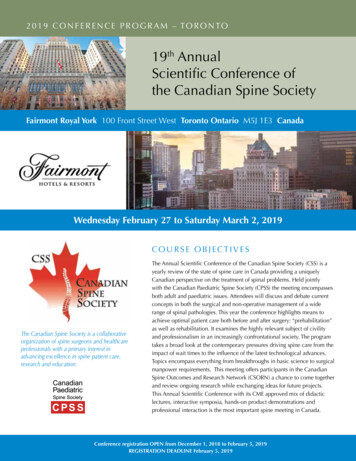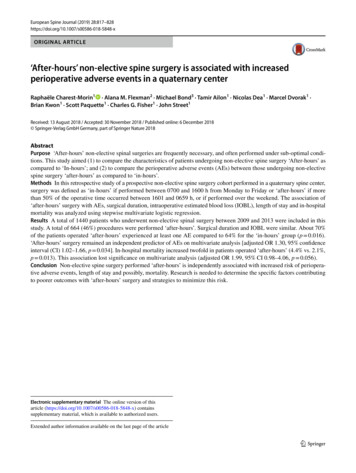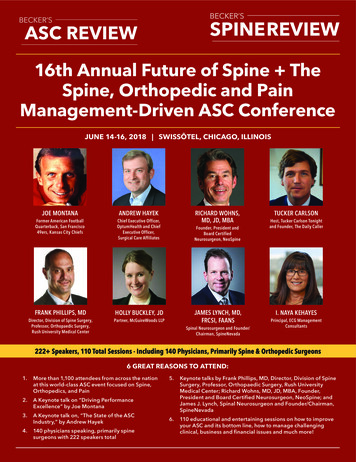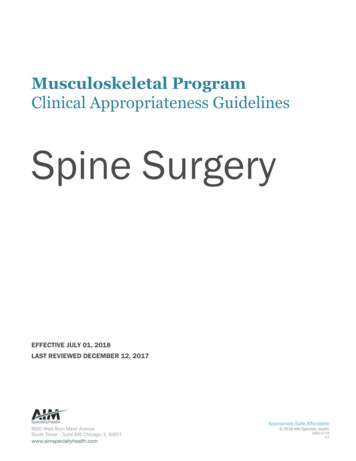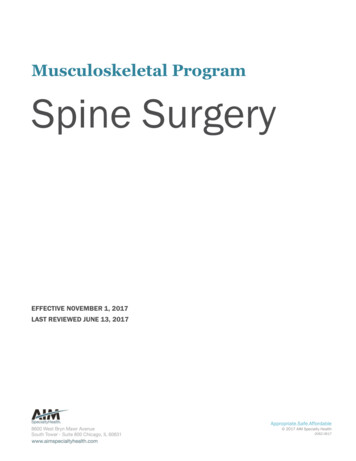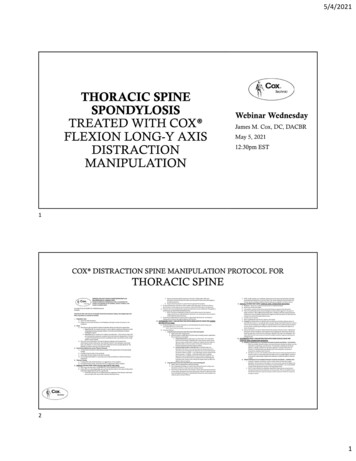
Transcription
5/4/2021121
5/4/2021“”342
5/4/2021563
5/4/2021784
5/4/20219105
5/4/202111126
5/4/202113147
5/4/202115168
5/4/2021ortextbook www.coxtrc.com17189
5/4/2021192010
PROTOCOL FOR COX TECHNIC FLEXION DISTRACTION ANDDECOMPRESSION OF THORACIC SPINE:THORACOLUMBAR DISC HERNIATION AS WELL AS DEGENERATIVESPONDYLOTIC CHANGES IN THE THORACIC, CERVICO‐THORACIC, ANDTHORACO‐LUMBAR SPINESby James M Cox DC DACBR FICC FIANM(H) HonDLitt5/3/2021All protocols start with and are continually monitored by tolerance testing. Neurological signs andtheir progression are monitored carefully.1. Preparatory Care.A. Ensure all locks are secure.B. Patient lies prone with the face on the headpiece with eyes in center of cutouts in theheadpiece.2. Notes.A. TDH (thoracic disc herniation) treatment basically utilizes two distraction approaches:i. From T1 to T9, the occipital restraint is used to deliver cephalward distraction whilecontacting the spinous process inferior to the TDH as the distraction Protocol Imobilization is givenii. From T9 to L2, the caudal section delivers the distraction. (Start without ankle cuffsand institute their placement as patient relief and tolerance testing allows.) ProtocolI is used. The doctor hand contact is a cephalward long‐y axis delivery as the caudalsection moves caudally.B. Start with manual distraction and careful tolerance testing until the patient hascentralization of pain to the spine; then institute Protocol II with testing for automatedlong‐y axis delivery. In some cases, the entire treatment will be manually delivered. Thisdepends on patient response and tolerance testing.3. Hand Contact Options for Various Thoracic Protocols.A. Full palm with the thenar on the spinous process of the superior level of the spine beingtreated.B. Knuckles along the sides of the vertebraeC. Index finger–thumb contact of the spinous processD. Two‐handed (while table is in auto long‐y axis mode controlled by control box setting orfootswitch)4. Tolerance Testing.A. If using ankle cuffs, check that there is no aggravation of the condition.B. If using the thoracic strap, check that there is no aggravation of the condition.5. MANUAL DISTRACTION USING CAUDAL SECTION OF THE TABLE.A. Start long‐y axis distraction manipulation for manual application of Protocol I.B. Ankle cuffs are in place depending upon patient tolerance; that is, if no sense of discomfortis felt when tested with the cuff on, use the cuff.i. Remember that here we are distracting many segments of the thoracic and lumbarspine so ankle cuffs may provide improved distraction force.
ii. Always treat below patient tolerance to the force. If that ankle cuffs causediscomfort, do not use them but rather use the patient’s lower extremity weight asthe distraction force.iii. Keep in mind that less force can be the best approach for patients.C. As manual distraction with flexion of the caudal section takes place, the doctor’s thenarhand contact is on the spinous process superior to the level of the spine to be distracted.D. Protocol I (five 4 second distraction session provided three times) is delivered. The patient isquizzed as to any discomfort during the process.i. NOTE: This form of distraction Protocol I can be delivered up to the foramenmagnum level thus providing full spine distraction. For some patients this provides acomfortable full spine distraction.E. Protocol II is started when the patient feels no discomfort with Protocol I via tolerancetesting which continues throughout delivery of Protocol II.6. AUTOMATED LONG‐Y AXIS DISTRACTION SPINE MOBILIZATION USING THE CAUDALSECTION OF THE TABLE.A. If manual long‐y axis Protocol I distraction is well tolerated by the patient, long‐y axisautomated distraction can be used.NOTE: Careful tolerance testing during this procedure is followed.B. Procedure Options:i. Using Attended Automated Axial Distraction Manually Applied1. Apply ankle cuffs, if appropriate.2. Allow the table to axially distract by foot strip or handle pressure application.The 2 methods are described:a. Using the footswitch, apply long‐y axis distraction. The level of thespine to be distracted is stabilized with a two‐handed contact of thespinous process as distraction is delivered. Release the foot switch toallow the table to return to neutral. Protocol I is delivered, andProtocol instituted as patient tolerance allows.b. Using the finger button on the tiller bar to institute long y axisdistraction, the doctor’s free hand contacts the spinous process toresist distraction and applies the distractive force at the desired level.The doctor’s thenar contact ‐ or an index finger–thumb contact of thespinous process ‐ is utilized. As the distraction force is appliedagainst the doctor stabilized spine level, Protocol I is delivered. Theusual five 4‐second distractions are applied at the isolated segmentuntil distraction motion is felt. Release the finger button to allow thetable to return to neutral.ii. Using Attended Automated Axial Distraction Automated Applied1. Ankle cuffs are used based on tolerance testing.2. The computerized settings are used so the instrument moves in long‐y axisdistraction to the force and movement settings desired.3. Distraction is delivered with a two‐handed contact of the appropriate spinousprocess at the appropriate level to be distracted. Protocol I is administered toeach level desired. Protocol II is started when Protocol I is well accepted, andradicular pain is at least 50% less.
C. NOTE: A high‐velocity, low‐amplitude adjustment may be given during lumbar attended‐automated axial distraction as just described. This can be applied at any desired level ofthoracic spine according to patient need and tolerance in a gentle, non‐force manner.7. MANUAL DISTRACTION USING CERVICAL AXIAL DISTRACTION HEADPIECE.A.B.C.D.E.F.G.H.Protocol I ‐ Apply the occipital restraint system to stabilize the head.Stand at the head of the table.Use a palmar contact on the spinous below the thoracic segment to be distractedPull on the ball handle of the cervical headpiece to distract the segment to the point ofelastic resistance. Move slightly beyond that point, minding at all times patient tolerance.Resistance or loss of mobility is distracted to regain such lost movement, all with tolerancetesting of the patient throughout the process.Gently return to neutral.Move caudad to the next thoracic spinous, and repeat.Protocol II is started when no radicular pain is present or presenting radicular pain is atleast 50% decreased or is no radicular pain is present. Always start with Protocol I to reducestenosis by increasing the disc height, increasing foraminal area and decreasing intradiscalpressure before instituting physiological range of motion to each distracted segment orseries of segments.Manual distraction can also be delivered with the occipital restraint in place. Cephalwarddistraction with the headpiece and occipital restraint applying the distraction, the doctorhand can move the cervico‐thoracic or thoracic segments into long‐y axis distraction. Thisstarts with Protocol I and moves to Protocol II as patient positive response and tolerancetesting permits.8. AUTOMATED LONG‐Y AXIS DISTRACTION SPINE MOBILIZATION USING THECERVICAL AXIAL DISTRACTON HEADPIECE.A. MANALLY CONTROLLED AUTO DISTRACTION WITH OCCIPITAL RESTRAINT ‐ FOOTSWITCHi. With the occipital restraint in place, and under tolerance testing, the doctor uses thefootswitch to start long‐y axis distraction. As distraction is delivered, the doctordelivers a cephalic resistance to the spine segment to institute distraction. AsProtocol I is well tolerated and radicular pain is 50% reduced or not present,Protocol II is instituted with Protocol I.ii. The doctor can use a two‐handed contact of the spinous at the appropriate level asthe foot switch to is pressed to allow the table to move caudally against resistanceof the doctor hand contact. Release the footswitch to allow the table to return toneutral.B. TIMER CONTROLLED AUTO DISTRACTION WITH OCCIPITAL RESTRAINT – CONTROL BOXi. Using the computer control box, set the caudal section of the table to applydistraction. Set the time for the table to run in auto mode, and set the distance fordistraction movement to be used while you adjust the patient. Use a two‐handedcontact of the appropriate spinous at the appropriate level.ii. NOTE: A high‐velocity, low‐amplitude adjustment may be given during thoracicattended automated axial distraction as just described. This can be applied at anydesired level of thoracic spine according to patient need and tolerance in a gentle,non‐force manner.
distraction to the force and movement settings desired. 3. Distraction is delivered with a two‐handed contact of the appropriate spinous process at the appropriate level to be distracted. Protocol I is administered to eac

